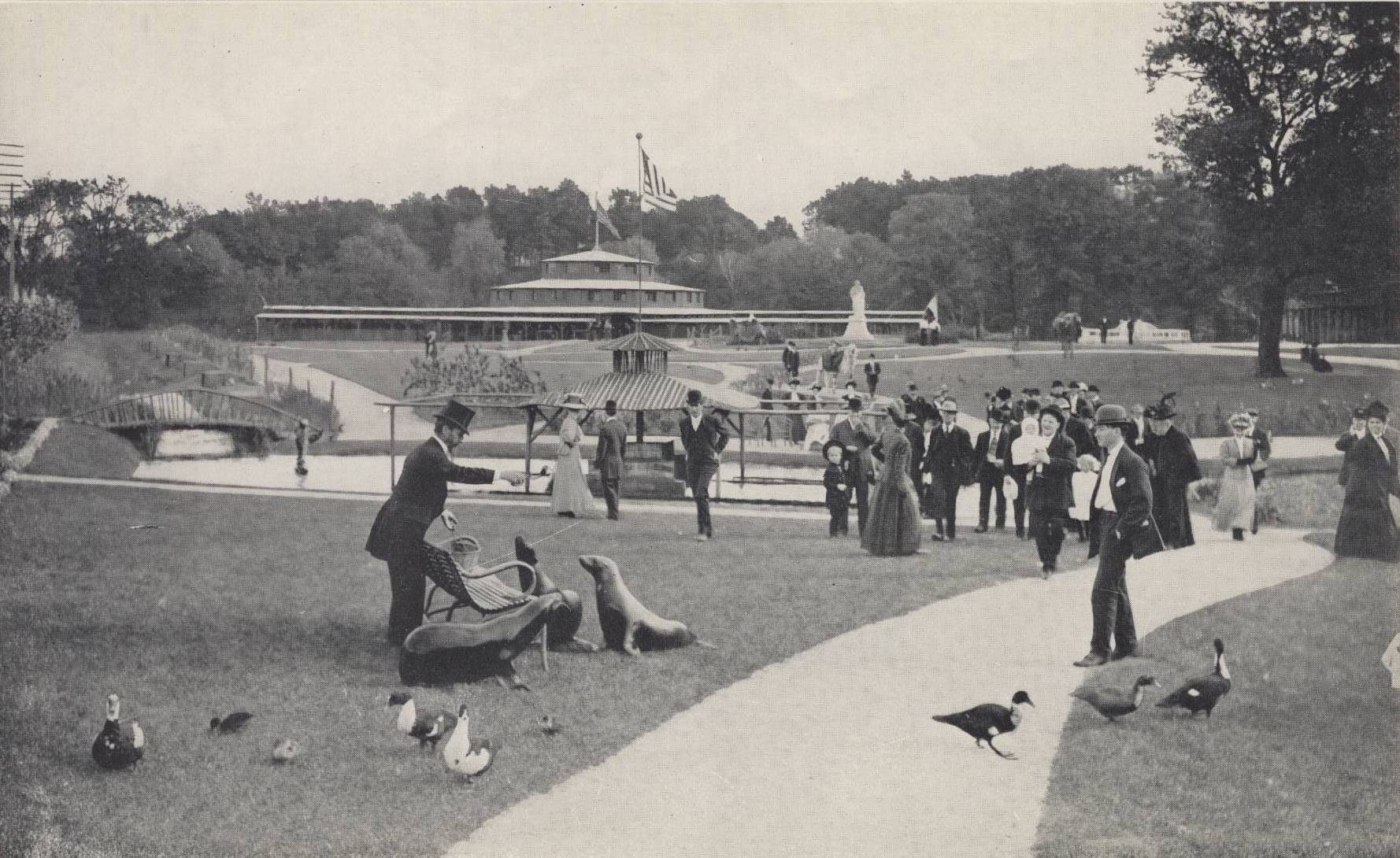
Today’s guest blogger is Kim Simmonds, alumna of the Augsburg College history program. A public historian currently working in a haunted historic house in Deadwood, South Dakota, Kim became fascinated with “Fish” Jones and began recording her findings on the Robert Fremont “Fish” Jones Facebook page while working for the Minneapolis Parks and Recreation Board. In part two, Kim continues the tale of zoo promoter and the Longfellow House.
As a devoted fan of the work of Henry Wadsworth Longfellow, R.F. Jones paid homage to the poet by building a 2/3 scale replica of Longfellow’s home in Cambridge, Massachusetts. The large Georgian-style yellow house was situated to the west of the Longfellow Zoological Gardens where Jones created a home for his menagerie. The showman redirected Minnehaha Creek to create swimming ponds for his seals, and in addition to a monkey house and aviary, Jones built a huge arena to house and perform with his animals, which included tigers, bears and elephants.
The zoo proved incredibly popular, drawing thousands of visitors each year. In July and August of 1907, the year it opened, over 60,000 people flocked to view the “1000 Living Sights.” As attendance increased, Jones built a train around his property to make getting around easier for his guests. He referenced Longfellow’s “The Song of Hiawatha” by naming each car after characters from the epic poem, the train drawn by the engine Nokomis. As a special touch, Jones commissioned a statue of Longfellow in 1908, which sat central to the grounds. $5000 was raised for the sculpture, with contributions made by prominent families of the time, including the Pillsburys, Washburns and Savages.
Although the zoo did well for many years, it was not without problems. In 1907, Jones grieved the loss of both a beloved seal and a cherished Russian wolfhound. In 1909, an elephant became enraged and destroyed his 24-foot tall cage before his trainers could contain him, all while spectators looked on. Animal cruelty charges plagued the naturalist, from eagles with frost bite to starving lions. By the early 1920s, the beginning of the end began for the Longfellow Zoological Gardens.
By 1922, Jones’ neighbors were fed up from lack of sleep. Birds screeched late into the night, causing elephants to trumpet while the lions roared. After a petition was filed by a neighborhood committee to oust the eccentric businessman from his property, the Minneapolis Park Board began proceedings to condemn the property. Jones made a deal with them: He would deed the property to the City if he was allowed to stay and run his zoo for 10 more years.
Jones, however, would not live to see his zoo close. On October 15, 1930, after an illness of four weeks, Jones died at his home. He was proclaimed “Picturesque City Figure” by the Minneapolis Tribune and buried at Lakewood Cemetery. Even though it was well known that Jones had deeded his land to the Park Board, his family contested the deed and his will, succeeding in keeping the zoo open for six more years. Jones’ family managed to get the case to the Supreme Court, but the court found in favor of the City, giving the family until July 1936 to vacate the premises. Some of the animals were given to the Como Zoo in Saint Paul, and Jones’ son, Roy, made an effort to create the first floating zoo on the Mississippi, on a ship called The Polar Bear.
After the zoo closed, the library board purchased the home converted the house into the Longfellow Community Library. In 1968, the library was moved to the newly built Nokomis Library, and the bottom level of the house was used as a warming shelter for skaters on Minnehaha Creek in the winter months. In the 1980s, the house was recycled into a haunted house attraction during October, a fitting use for the house that had fallen into bad disrepair.
Luckily, a group of concerned citizens banded together and formed the Longfellow House Restoration Committee. They slowly began to make improvements on the structure with the help of local civic and military organizations. In the early 1990s, as plans were being made to build Highway 55 through the center of the property, the restoration group had the house moved to its present location at the intersection of Minnehaha Avenue and East Minnehaha Parkway. A land bridge now separates the house from the only remaining part of zoo, the statue of Longfellow. A few artifacts from Jones’ days survive, including his famous top hat and a suit jacket, on display with the hide of Hiawatha at the Hennepin History Museum. The Park Board now runs the house as a visitor center, open on weekends and holidays during the summer.
Photo of R.F. Jones Longfellow House, 4001 Minnehaha Parkway c. 1910, comes courtesy of the Library of Congress.
Photo of Robert Fremont “Fish” Jones feeding his seals on the grounds of Longfellow Zoological Gardens. Photo from the 1912 Longfellow Gardens Souvenir booklet, courtesy of the Hennepin County Library Special Collections.
